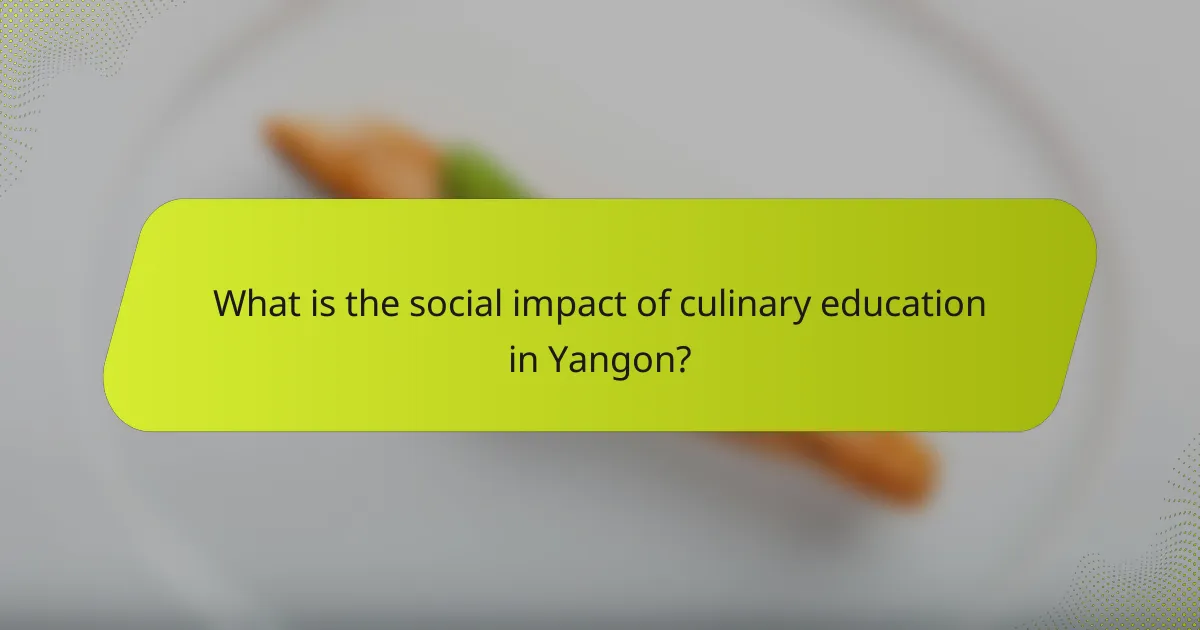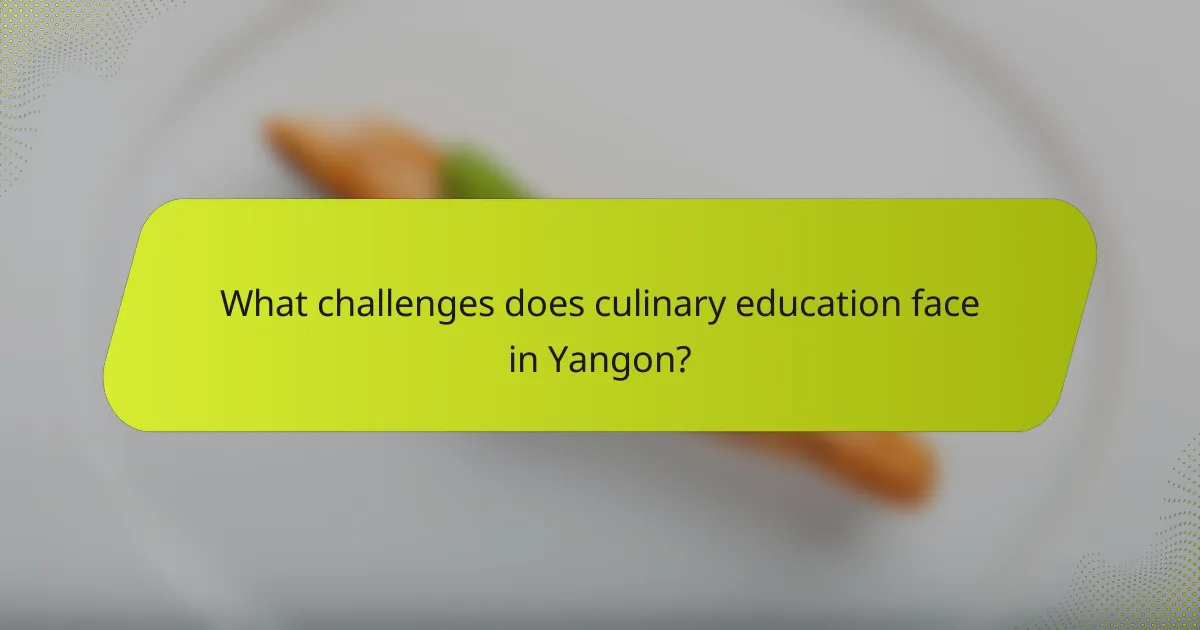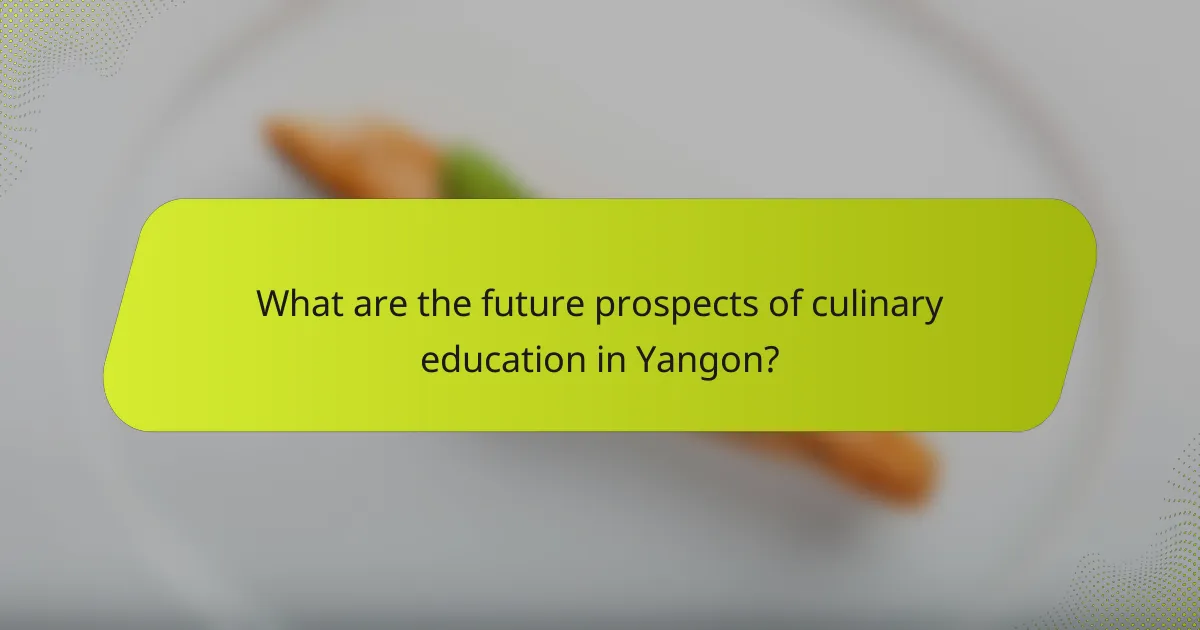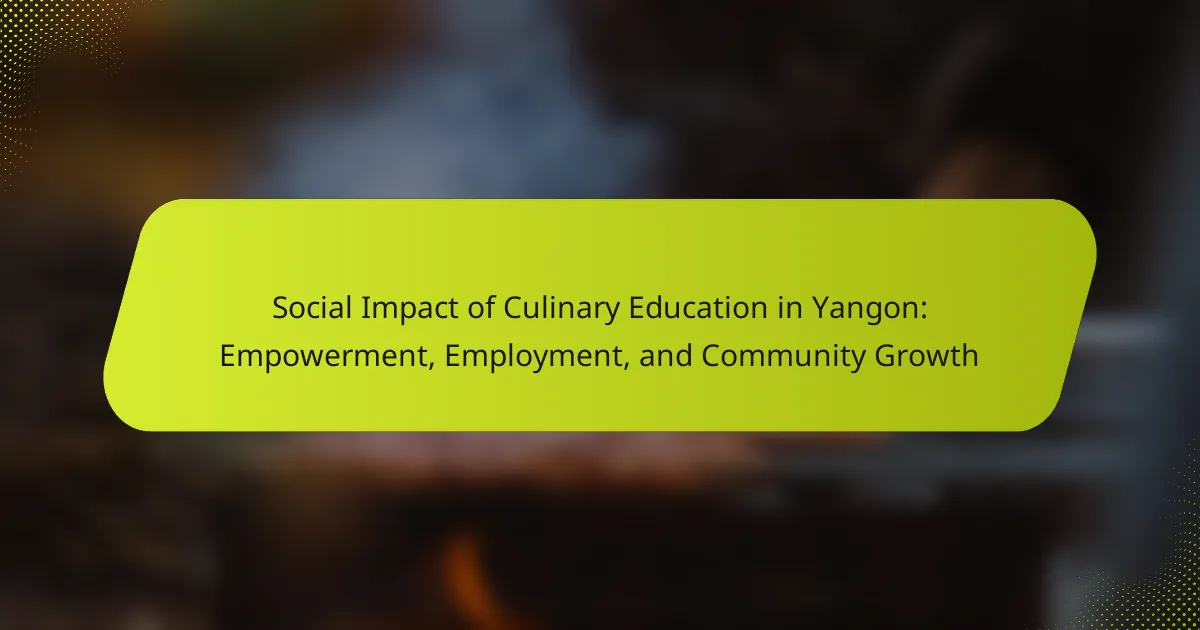Culinary education in Yangon plays a significant role in shaping social dynamics by equipping individuals with essential skills for employment within the hospitality sector. This education not only enhances job opportunities in restaurants, hotels, and catering services but also contributes to economic stability for families and community growth through the preservation of local food culture. Graduates are encouraged to pursue entrepreneurship, which further bolsters local economies and helps reduce poverty levels. Additionally, culinary programs foster an appreciation for regional heritage and ingredients, while addressing common misconceptions about culinary careers, highlighting their diverse opportunities and the importance of formal training. As the food industry in Yangon continues to expand, the demand for trained culinary professionals is expected to rise, leading to enhanced employment prospects and community development.

What is the social impact of culinary education in Yangon?
Culinary education in Yangon significantly impacts social dynamics by empowering individuals with skills for employment. It enhances job opportunities in the growing hospitality sector. Graduates often find work in restaurants, hotels, and catering services. This leads to increased economic stability for families. Furthermore, culinary education fosters community growth through local food culture preservation. It encourages entrepreneurship among graduates, contributing to local economies. Studies show that culinary programs can reduce poverty levels by providing sustainable livelihoods. Overall, culinary education plays a crucial role in social development in Yangon.
How does culinary education empower individuals in Yangon?
Culinary education empowers individuals in Yangon by providing them with essential skills and knowledge in food preparation and service. This education enhances employability within the growing hospitality and restaurant sectors. Graduates often secure jobs in local eateries, hotels, and catering services. Culinary programs also foster entrepreneurship by equipping individuals to start their own food-related businesses.
Furthermore, these educational initiatives promote cultural heritage through the preservation of traditional cooking techniques. They encourage creativity and innovation in culinary practices. Access to culinary education can lead to improved economic stability for families. Overall, culinary education serves as a catalyst for personal and community development in Yangon.
What skills are developed through culinary education?
Culinary education develops various essential skills. These skills include food preparation techniques, which encompass knife skills and cooking methods. Students learn menu planning and recipe development. Time management is crucial in a kitchen setting, enhancing efficiency. Sanitation and food safety practices are emphasized to ensure health standards. Additionally, culinary education fosters teamwork and communication skills in collaborative environments. Business management knowledge is often included, preparing students for culinary entrepreneurship. These skills are vital for career opportunities in the culinary industry.
How does culinary education enhance self-esteem and confidence?
Culinary education enhances self-esteem and confidence by equipping individuals with practical skills. Learning to cook fosters a sense of accomplishment. Students gain mastery over various cooking techniques. This mastery leads to increased confidence in their abilities. Additionally, culinary education often involves teamwork and collaboration. These social interactions build a supportive community. Positive feedback from peers and instructors reinforces self-worth. Research indicates that skill acquisition is linked to higher self-esteem levels. In a study by the Journal of Culinary Education, participants reported significant boosts in confidence after completing culinary programs.
What role does culinary education play in employment opportunities?
Culinary education significantly enhances employment opportunities in the food industry. It equips individuals with essential skills and knowledge required for various culinary roles. Graduates often find positions in restaurants, hotels, and catering services. According to the National Restaurant Association, over 1 million new restaurant jobs are projected in the next decade. Culinary programs also provide networking opportunities, connecting students with industry professionals. This connection can lead to internships and job placements. Additionally, culinary education fosters entrepreneurship, enabling graduates to start their own businesses. Overall, culinary education plays a crucial role in improving job prospects and career advancement in the culinary field.
How does culinary education align with job market demands?
Culinary education aligns with job market demands by equipping students with essential skills required in the food industry. Programs focus on practical training, including cooking techniques and food safety standards. This hands-on approach meets the industry’s need for skilled labor. Employers seek graduates who can adapt to fast-paced environments and understand culinary trends. Statistics show that culinary graduates have higher employment rates in restaurants and hospitality sectors. Additionally, culinary schools often collaborate with local businesses to ensure curriculum relevance. This partnership keeps education aligned with evolving job market needs.
What types of employment are available for culinary graduates?
Culinary graduates can pursue various types of employment in the food industry. Common roles include chef positions in restaurants, catering services, and hotels. They may also work as bakers or pastry chefs in bakeries. Additionally, culinary graduates can find opportunities in food styling and food photography. Some may become food writers or bloggers, sharing recipes and culinary experiences. Others may work in food service management or as culinary instructors. The demand for skilled culinary professionals continues to grow, reflecting the industry’s expansion. According to the Bureau of Labor Statistics, employment in food preparation and serving is projected to grow by 10% from 2019 to 2029.
How does culinary education contribute to community growth in Yangon?
Culinary education contributes to community growth in Yangon by enhancing local employment opportunities. Graduates from culinary programs often find jobs in restaurants, hotels, and catering services. This increase in employment supports local economies. Culinary education also promotes entrepreneurship among graduates. Many start their own food businesses, contributing to the diversity of local cuisine. Additionally, culinary programs often include community service components. This fosters collaboration and strengthens community ties. Overall, culinary education plays a vital role in economic and social development in Yangon.
What initiatives support community engagement through culinary education?
Initiatives that support community engagement through culinary education include local cooking classes, food festivals, and community kitchens. These programs foster skill development and promote cultural exchange. For example, local cooking classes often involve residents teaching traditional recipes. Food festivals provide a platform for local chefs to showcase their culinary skills. Community kitchens allow individuals to collaborate and share resources. Research shows that such initiatives enhance community ties and improve food literacy. The Culinary Institute of America has documented that culinary education can lead to increased job opportunities and community cohesion.
How does culinary education promote local culture and cuisine?

What challenges does culinary education face in Yangon?
Culinary education promotes local culture and cuisine by preserving traditional cooking techniques and recipes. It equips students with skills to create authentic dishes that reflect regional heritage. This education fosters appreciation for local ingredients and flavors. By incorporating cultural history into the curriculum, students gain a deeper understanding of their culinary roots. Culinary schools often collaborate with local chefs and artisans, enhancing community ties. Events and competitions organized by these institutions showcase local cuisine to a broader audience. This visibility helps sustain local food traditions and encourages tourism. Ultimately, culinary education serves as a vital link between generations, ensuring cultural continuity.
How do economic factors impact culinary education accessibility?
Economic factors significantly impact culinary education accessibility. High tuition fees can limit enrollment for low-income students. Additionally, the availability of financial aid influences students’ ability to afford culinary programs. Economic downturns often lead to reduced funding for educational institutions, affecting resources and program offerings. Job market fluctuations can also determine the perceived value of culinary education. In regions with strong culinary tourism, demand for trained chefs increases, enhancing program accessibility. Conversely, in areas with limited economic growth, culinary education may suffer from decreased enrollment and funding.
What are the financial barriers for students in culinary programs?
Financial barriers for students in culinary programs include high tuition costs and additional fees. Many culinary schools charge significant amounts for enrollment. Students often face expenses for kitchen supplies, uniforms, and textbooks. Additionally, living costs can be burdensome for those attending school. Limited access to financial aid can exacerbate these challenges. Scholarships for culinary students are often scarce. The combination of these factors can deter potential applicants from pursuing culinary education. According to the National Center for Education Statistics, the average annual cost of tuition and fees for culinary programs can exceed $20,000.
How do resource limitations affect the quality of culinary education?
Resource limitations significantly hinder the quality of culinary education. Limited access to quality ingredients restricts hands-on learning experiences. Inadequate kitchen facilities prevent students from practicing essential cooking skills. Insufficient funding leads to fewer teaching resources and outdated equipment. This results in a lack of exposure to modern culinary techniques. Consequently, students may struggle to compete in the job market. Research indicates that culinary programs with better resources produce graduates with higher employment rates. For instance, a study by the Culinary Institute of America found that resource-rich programs enhance student learning outcomes.
What societal perceptions influence culinary education in Yangon?
Societal perceptions influencing culinary education in Yangon include views on the value of culinary skills and the role of chefs. Many people see culinary education as a pathway to stable employment. This perception drives enrollment in culinary programs. Additionally, there is a growing appreciation for local cuisine and its cultural significance. This appreciation encourages students to pursue culinary arts. The perception of chefs as respected professionals also enhances the appeal of culinary education. Furthermore, societal beliefs about food safety and nutrition impact curriculum focus. These perceptions collectively shape the landscape of culinary education in Yangon.
How does stigma around vocational training impact enrollment?
Stigma around vocational training negatively impacts enrollment. Many individuals perceive vocational training as inferior to traditional academic paths. This perception leads to a lack of interest among potential students. According to a study by the World Bank, countries with strong vocational training stigma see lower enrollment rates. In some regions, enrollment can be reduced by as much as 30% due to these negative perceptions. Additionally, families may discourage students from pursuing vocational education. This further limits the number of individuals entering vocational programs. Ultimately, stigma creates barriers to accessing valuable training opportunities.
What misconceptions exist about culinary careers?

What are the future prospects of culinary education in Yangon?
Culinary careers are often misunderstood as being solely about cooking. Many believe these careers lack stability and financial security. In reality, culinary professionals can find diverse opportunities in various sectors. These include restaurants, catering, food media, and education. Another misconception is that culinary education is unnecessary for success. However, formal training can enhance skills and open doors to higher positions. Additionally, some think culinary jobs are only for those passionate about food. In truth, culinary careers also require business acumen and management skills. The future prospects of culinary education in Yangon are promising. As the food industry grows, demand for trained professionals increases. Culinary programs in Yangon are expanding to meet this need. This growth can lead to enhanced employment opportunities and community development.
How can culinary education evolve to meet changing needs?
Culinary education can evolve to meet changing needs by integrating modern technology and sustainability practices. Programs should include digital tools for menu planning and food safety management. This adaptation prepares students for the tech-driven restaurant industry. Incorporating local ingredients and sustainable practices aligns with global food trends. Training in plant-based cooking can address dietary shifts toward healthier lifestyles. Collaborations with local businesses can provide real-world experience for students. Additionally, flexible learning options, such as online courses, can accommodate diverse learners. This evolution ensures culinary education remains relevant and impactful in a changing landscape.
What innovations can enhance culinary training programs?
Innovations that can enhance culinary training programs include the integration of technology, such as virtual reality and online platforms. Virtual reality allows students to practice cooking in a simulated environment. This technology can enhance skills without the need for physical ingredients. Online platforms facilitate access to a wider range of culinary resources and expert tutorials.
Another innovation is the implementation of farm-to-table concepts in training. This approach teaches students about sourcing local ingredients and sustainability. It connects culinary education with community agriculture. Additionally, partnerships with local restaurants can provide hands-on experience. Students gain real-world exposure and networking opportunities through these collaborations.
Incorporating diverse cuisines into the curriculum can also enhance culinary training. This broadens students’ culinary perspectives and prepares them for global culinary trends. Finally, mentorship programs with industry professionals can offer invaluable guidance. Such programs can help students navigate their careers effectively.
How can partnerships with local businesses improve outcomes?
Partnerships with local businesses can significantly improve outcomes in culinary education. They provide students with real-world experience and job placement opportunities. Collaborating with businesses enhances curriculum relevance by aligning training with industry needs. Local businesses can offer mentorship and networking opportunities for students. These partnerships can also lead to funding and resources for educational programs. In Yangon, such collaborations can foster community growth and economic empowerment. Successful models show that students gain skills that directly translate to employment in their local economy.
What best practices can be implemented for successful culinary education?
Successful culinary education can be implemented through hands-on training, mentorship programs, and community engagement. Hands-on training enhances practical skills essential for culinary professionals. Mentorship programs connect students with experienced chefs, providing guidance and industry insights. Community engagement fosters collaboration with local businesses and organizations. Integrating local cuisine into the curriculum enriches cultural understanding. Regular feedback from students and industry partners ensures continuous improvement. Implementing these practices can lead to higher employment rates and community growth. Studies show that practical experience increases job readiness in culinary graduates.
How can community involvement strengthen culinary education initiatives?
Community involvement can strengthen culinary education initiatives by providing resources, expertise, and support. Local businesses can offer internships and job placements for students. This real-world experience enhances learning and prepares students for the job market. Community members can also share traditional cooking techniques and recipes. This enriches the curriculum and preserves local culinary heritage. Additionally, community events can raise awareness and funds for culinary programs. Engaging local chefs as mentors fosters collaboration and skill development. Research shows that community-supported programs improve student outcomes and increase enrollment. Overall, active community participation creates a robust network that benefits culinary education initiatives.
What strategies can be adopted to increase student engagement?
Incorporating interactive teaching methods can significantly increase student engagement. Strategies such as group discussions, hands-on cooking sessions, and real-world culinary projects foster active participation. Utilizing technology, like cooking apps and online resources, also enhances learning experiences. Providing opportunities for student-led initiatives encourages ownership and accountability. Additionally, connecting culinary lessons to local culture and community needs makes learning relevant. Research shows that engaged students are more likely to retain information and develop skills. For instance, a study by the National Education Association found that active learning can improve student outcomes by up to 50%.
The primary entity of this article is culinary education in Yangon. The article examines the social impact of culinary education, highlighting its role in empowering individuals through skill development, enhancing employment opportunities in the hospitality sector, and fostering community growth. It outlines the skills acquired through culinary programs, their effect on self-esteem, and the alignment with job market demands. Additionally, the article addresses the challenges faced by culinary education, including economic barriers and societal perceptions, while exploring future prospects and innovations that can enhance culinary training. Overall, it underscores the significance of culinary education in promoting economic stability and preserving local culture in Yangon.
